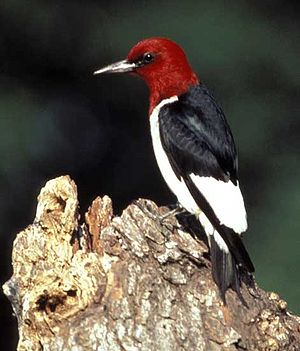Difference between revisions of "Field Guide/Birds/Melanerpes erythrocephalus"
m (57 revisions: re-import from WB, including edit history) |
|||
| (33 intermediate revisions by 4 users not shown) | |||
| Line 1: | Line 1: | ||
| − | {{ | + | {{Bird id |
| − | + | | name = Red-headed Woodpecker | |
| − | + | | latin_name = Melanerpes erythrocephalus | |
| − | + | | level = 4 | |
| − | + | | image_1 = Melanerpes erythrocephalus FWS.jpg | |
| − | + | | caption_1 = Red-headed Woodpecker | |
| − | + | | description = The '''Red-headed Woodpecker''', ''Melanerpes erythrocephalus'', is a small or medium-sized woodpecker. | |
| − | |||
| − | |||
| − | |||
| − | |||
| − | |||
| − | |||
| − | The '''Red-headed Woodpecker''', ''Melanerpes erythrocephalus'', is a small or medium-sized | ||
| − | Adults have a black back and tail with a red head and neck. Their underparts are mainly white. The wings are black with white secondaries. Non- | + | Adults have a black back and tail with a red head and neck. Their underparts are mainly white. The wings are black with white secondaries. Non-birders often mistakenly identify the Red-bellied Woodpecker as this species. |
| − | Their breeding habitat is open country across southern | + | Their breeding habitat is open country across southern Canada and the eastern-central United States. They nest in a cavity in a dead tree or a dead part of a tree. |
| − | Northern birds | + | Northern birds migrate to the southern parts of the range; southern birds are often permanent residents. |
| − | These birds fly to catch | + | These birds fly to catch insects in the air or on the ground, forage on trees or gather and store nuts. They are omnivorous, eating insects, seeds, fruits, berries and nuts. |
| − | + | Once abundant, populations have seriously declined since 1966 due to increased nesting competition from starlings and removal of dead trees (used as nesting sites) from woodlands. Many Northeastern states no longer have nesting red-headed woodpeckers. | |
| − | |||
They give a "tchur-tchur" call or drum on territory. | They give a "tchur-tchur" call or drum on territory. | ||
| − | + | To see and hear the Red Headed Woodpecker please click this link, http://www.youtube.com/watch?v=Ic6YPqC2wfU | |
| − | |||
| − | |||
| − | + | The red-headed woodpecker is listed as a vulnerable species in Canada and as a threatened species in some states in the US. The species has declined in numbers due to habitat loss caused by harvesting of snags, agricultural development, channeling of rivers, a decline in farming resulting to regeneration of eastern forests, monoculture crops, the loss of small orchards, and treatment of telephone poles with creosote. | |
| − | [[ | + | }}<noinclude>[[Category:Adventist Youth Honors Answer Book/Transcluded Modules|{{FULLCHAPTERNAME}}]]</noinclude> |
Latest revision as of 19:13, 5 July 2012
| Melanerpes erythrocephalus (Red-headed Woodpecker) | |
|---|---|
| Description | |
| The Red-headed Woodpecker, Melanerpes erythrocephalus, is a small or medium-sized woodpecker.
Adults have a black back and tail with a red head and neck. Their underparts are mainly white. The wings are black with white secondaries. Non-birders often mistakenly identify the Red-bellied Woodpecker as this species. Their breeding habitat is open country across southern Canada and the eastern-central United States. They nest in a cavity in a dead tree or a dead part of a tree. Northern birds migrate to the southern parts of the range; southern birds are often permanent residents. These birds fly to catch insects in the air or on the ground, forage on trees or gather and store nuts. They are omnivorous, eating insects, seeds, fruits, berries and nuts. Once abundant, populations have seriously declined since 1966 due to increased nesting competition from starlings and removal of dead trees (used as nesting sites) from woodlands. Many Northeastern states no longer have nesting red-headed woodpeckers. They give a "tchur-tchur" call or drum on territory. To see and hear the Red Headed Woodpecker please click this link, http://www.youtube.com/watch?v=Ic6YPqC2wfU The red-headed woodpecker is listed as a vulnerable species in Canada and as a threatened species in some states in the US. The species has declined in numbers due to habitat loss caused by harvesting of snags, agricultural development, channeling of rivers, a decline in farming resulting to regeneration of eastern forests, monoculture crops, the loss of small orchards, and treatment of telephone poles with creosote. | |

